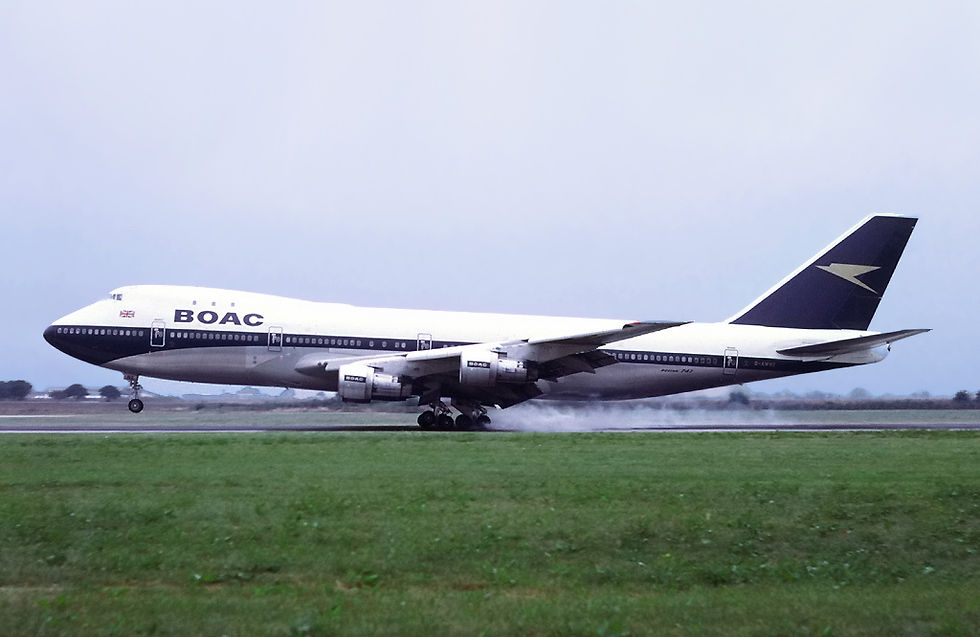The Last 747
- Kevan James
- Dec 23, 2022
- 3 min read

Kevan James,
December 2022
The last ever built Boeing 747 has rolled out from the Everett factory in the state of Washington.
The aircraft is a 747-8F and is the last produced by Boeing, 54 years after the first, also built at Everett, at the same plant and in the same building. As with all the others, the 1,574th 747 will be painted, test-flown by Boeing pilots before being handed over to cargo and charter carrier Atlas early next year.
The building at Everett — the largest in the world by volume, according to Boeing - was constructed specifically for production of the 747 in 1967.
The type’s first flight took place on February 9, 1969, and the 747 was certified in December of that year. It entered service with Pan Am on January 22, 1970, with the aircraft quickly dubbed ‘The Jumbo Jet’. The nickname has stuck to it ever since, as well as later being applied to other wide-body airliners
"For more than half a century, tens of thousands of dedicated Boeing employees have designed and built this magnificent airplane that has truly changed the world. We are proud that this plane will continue to fly across the globe for years to come," said Kim Smith, Boeing Vice President and general manager, 747 and 767 Programs.

The final aircraft is a 747-8 Freighter. This model has a revenue payload of 133.1 tonnes, enough to transport 10,699 solid-gold bars or approximately 19 million ping-pong balls or golf balls.
The economic business model of air cargo carriers is not quite the same as that applicable to passenger-only operations and outside the freight sector, Boeing 747 aircraft have now become rare in commercial fleets. And it hasn’t been solely the result of the devastation caused by COVID-19. For example, United and Delta waved farewell to theirs sometime before the pandemic, while British Airways retired their 747s in 2020 during the worldwide travel slump caused by government response to it.
On March 10, 1972 Boeing delivered the first wide-body freighter, a 747-200, to Lufthansa. The delivery marked a new era in cargo shipping: The expanded capability of the 747, with its nose door that could load huge objects, meant that shippers and freight forwarders could deliver more goods faster than shipping by sea or truck.
“The ability to ship more goods by air changed global trade overnight,” said Darren Hulst, vice president of Commercial Marketing. “People around the world could receive goods in days instead of months. Boeing freighters played a significant role in that, and they continue to define the art of the possible today in e-commerce and global trade thanks to their efficiency, versatility and our continuous product innovation to support tomorrow’s market needs.”
Today, 90% of the world’s freighter capacity is flown on Boeing freighters, which carry millions of tonnes of goods around the globe. According to Boeing’s 2021 Commercial Market Outlook, the global freighter fleet (production and conversions) is forecast to grow more than 70% from 2019, amounting to 2,610 new freighter deliveries in the next two decades.
For a huge number of people, the Boeing 747 had become the standard of travel. In the relatively short time since it began to leave the passenger-carrying skies, it has been sorely missed. And it will still be for some time still to come.
© Kevan James/KJM Today, 2022
Images - Paul Weatherman/Boeing
Looking Back...

Then First lady Pat Nixon christens the first 747 in January 1970 at Washington's Dulles Airport
WHPO2749-18

At one time, Japan Air Lines operated the largest fleet of 747s in the world
San Diego Air and Space Museum

The 747 became the mainstay of routes to and from Australia and for a lengthy time, the only aircraft type used by QANTAS
Dejan Milinkovic

Lufthansa maintained a substantial fleet, and included two aircraft for its charter subsidiary, Condor
Above - Peter Bakima
Below - Daniel Tanner


Belgian national airline Sabena were never as big a user as other carriers but still used the 747-200 and the 747-300
Mike Freer

BOAC's introduction of the 747 was delayed by industrial action on behalf of its pilots, who wanted increased pay to fly the type. Nevertheless, BOAC and then British Airways became one of the world's biggest operators.
Richard Vandervord

South African's 747s were daily visitors to London Heathrow
Steve Fitzgerald

Singapore Airlines pioneered use of the 747-300, naming the extended upper deck version the 'Big Top'. When the 747-400 came along, SIA called them the 'Mega Top'.
Steve Knight

Although seen worldwide in the colours of Pan Am and Twa, along with Northwest across the Pacific, most US airlines, although ordering the 747, found it too big for domestic use. One exception was United Airlines, who used the aircraft throughout its service life.
Jon Proctor

Above and below -The first 747 freighter
Boeing


1992 and the first 747-400F for Cargolux
Boeing


